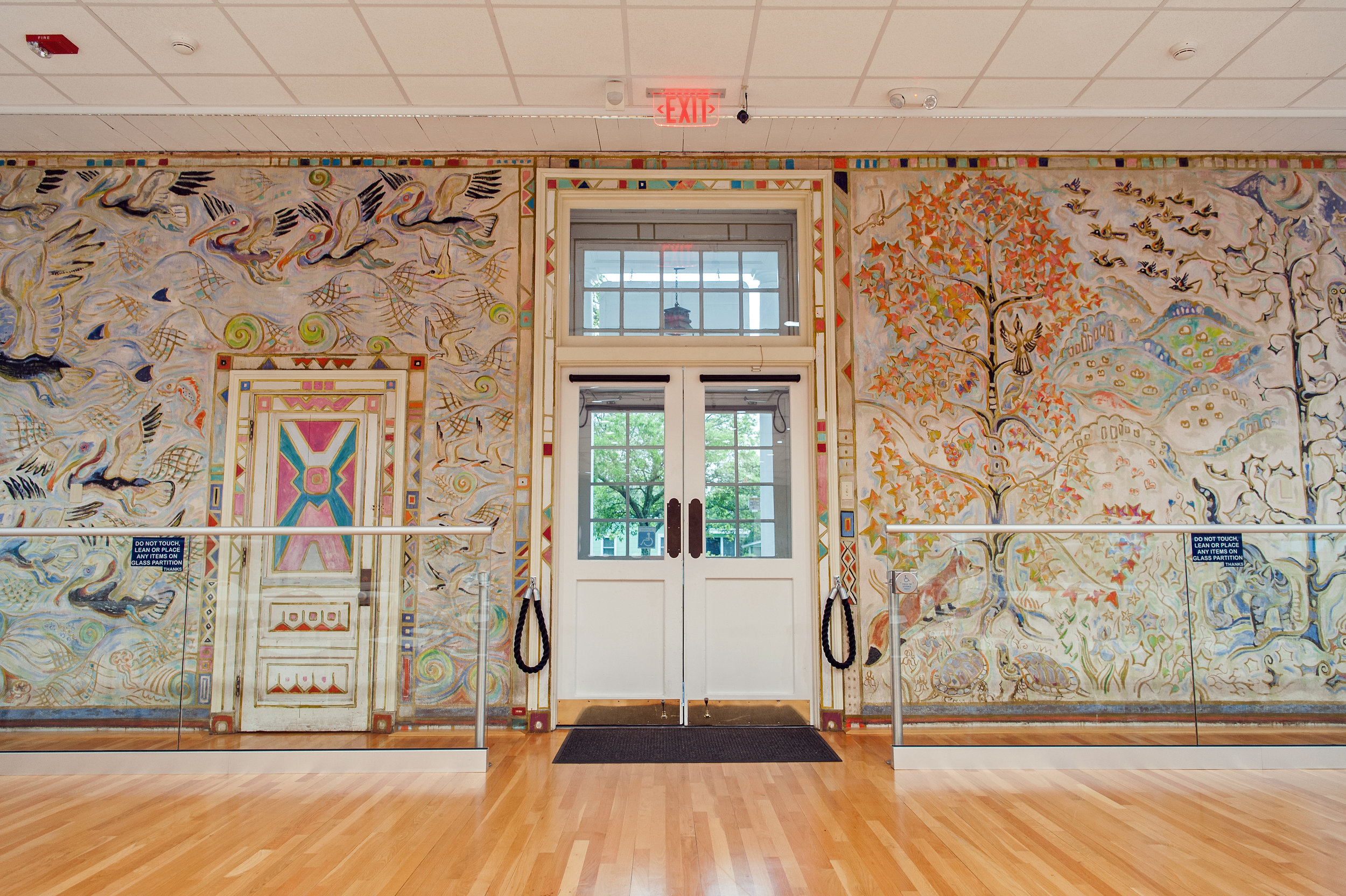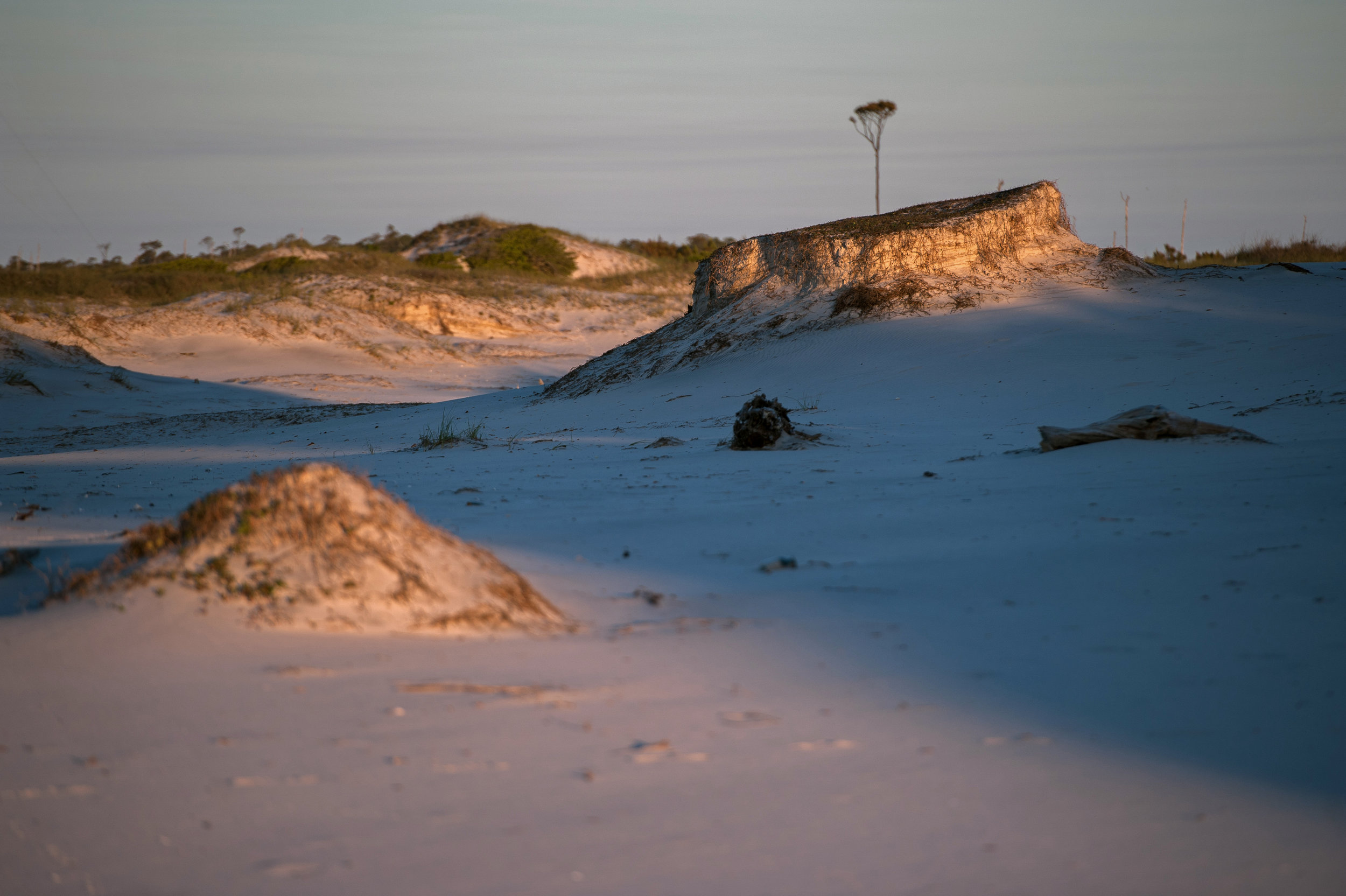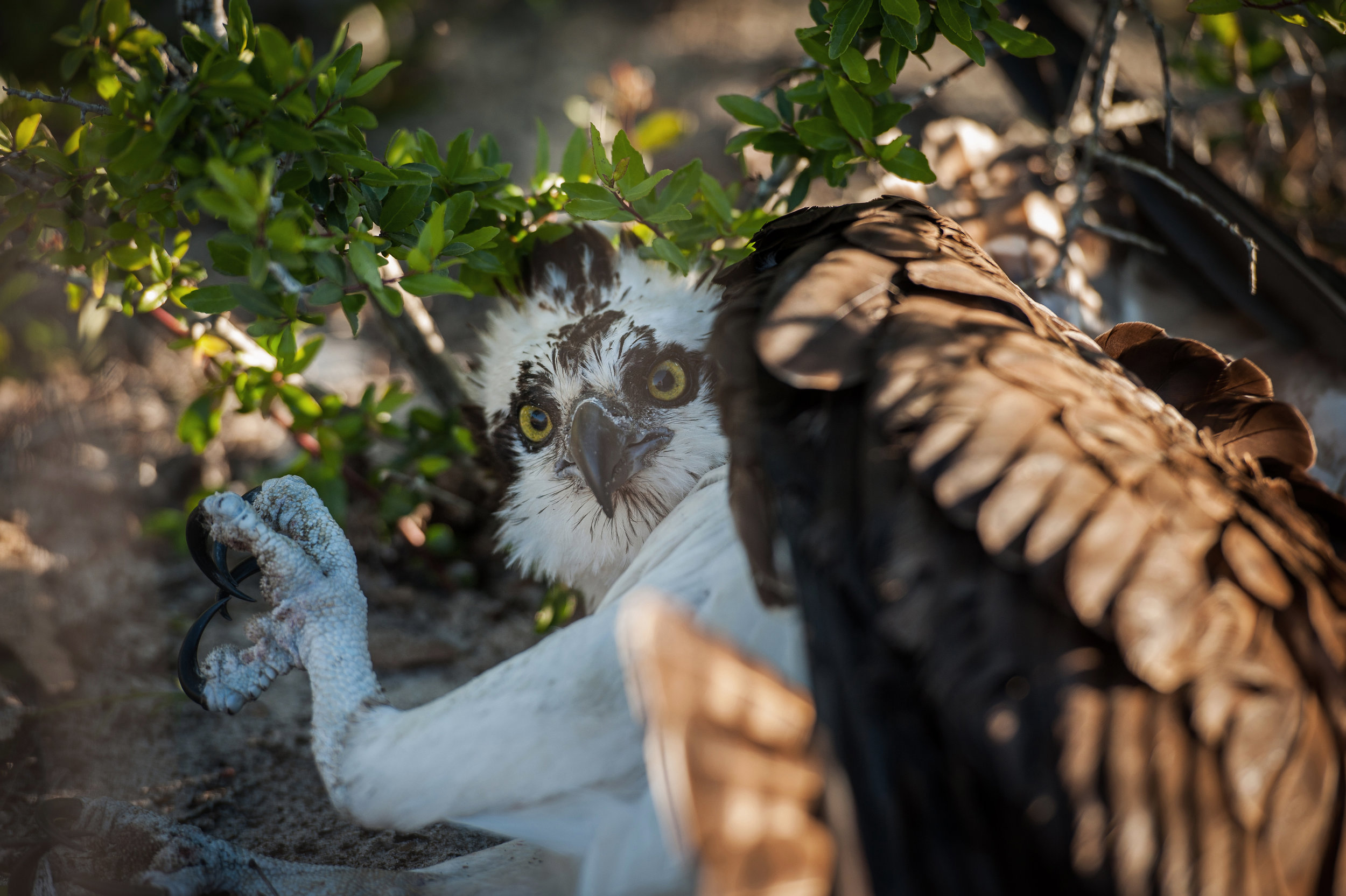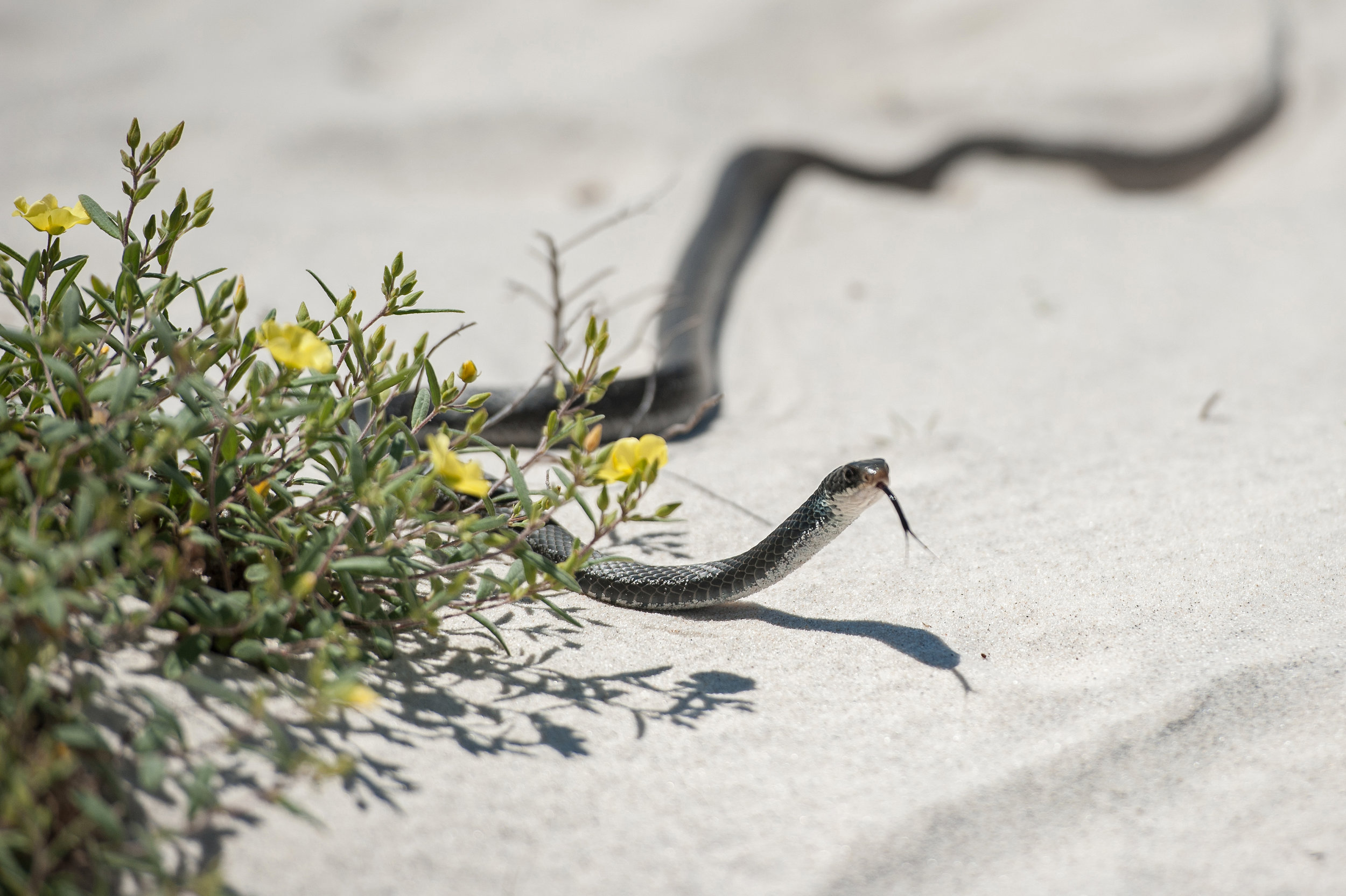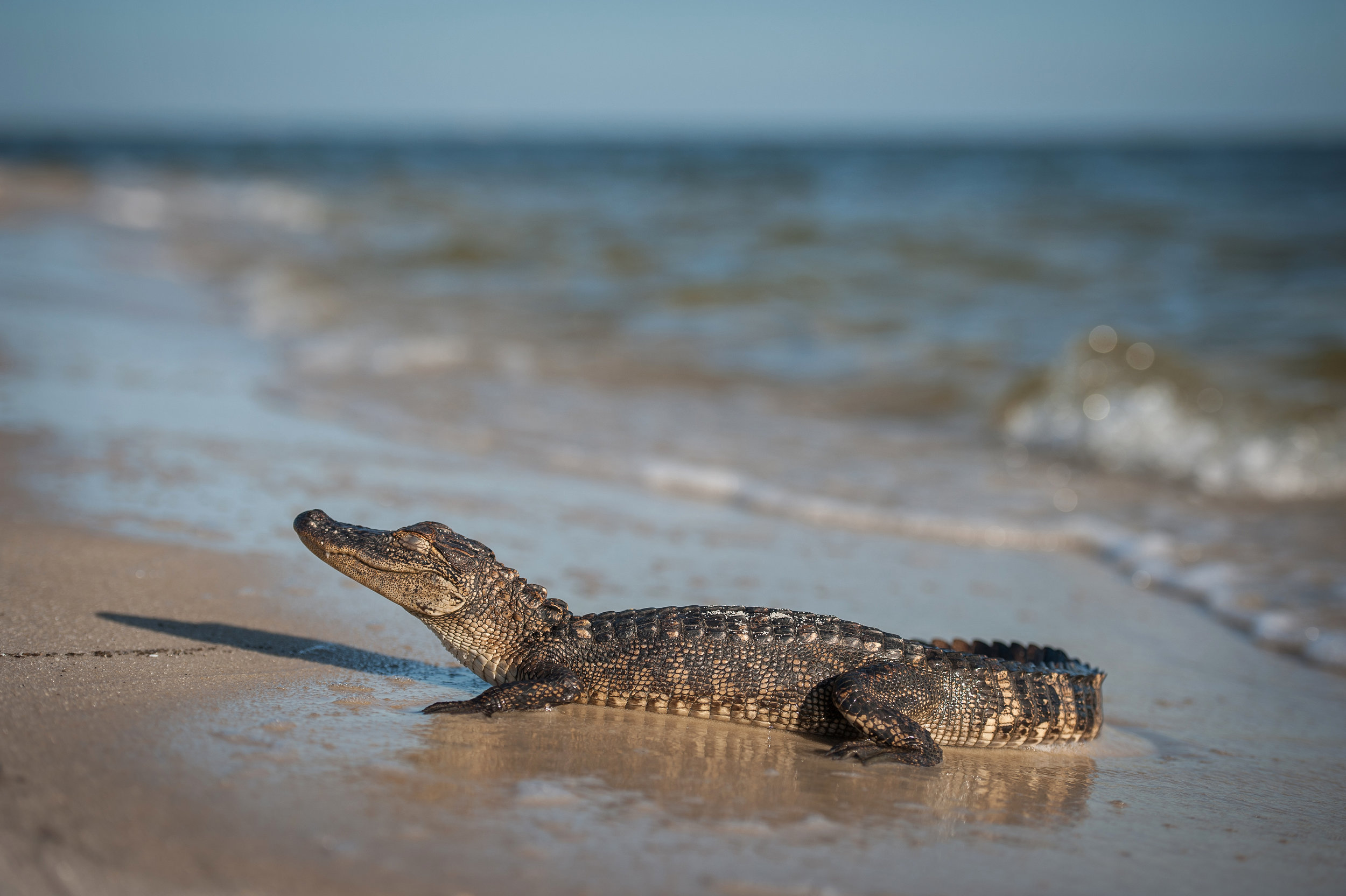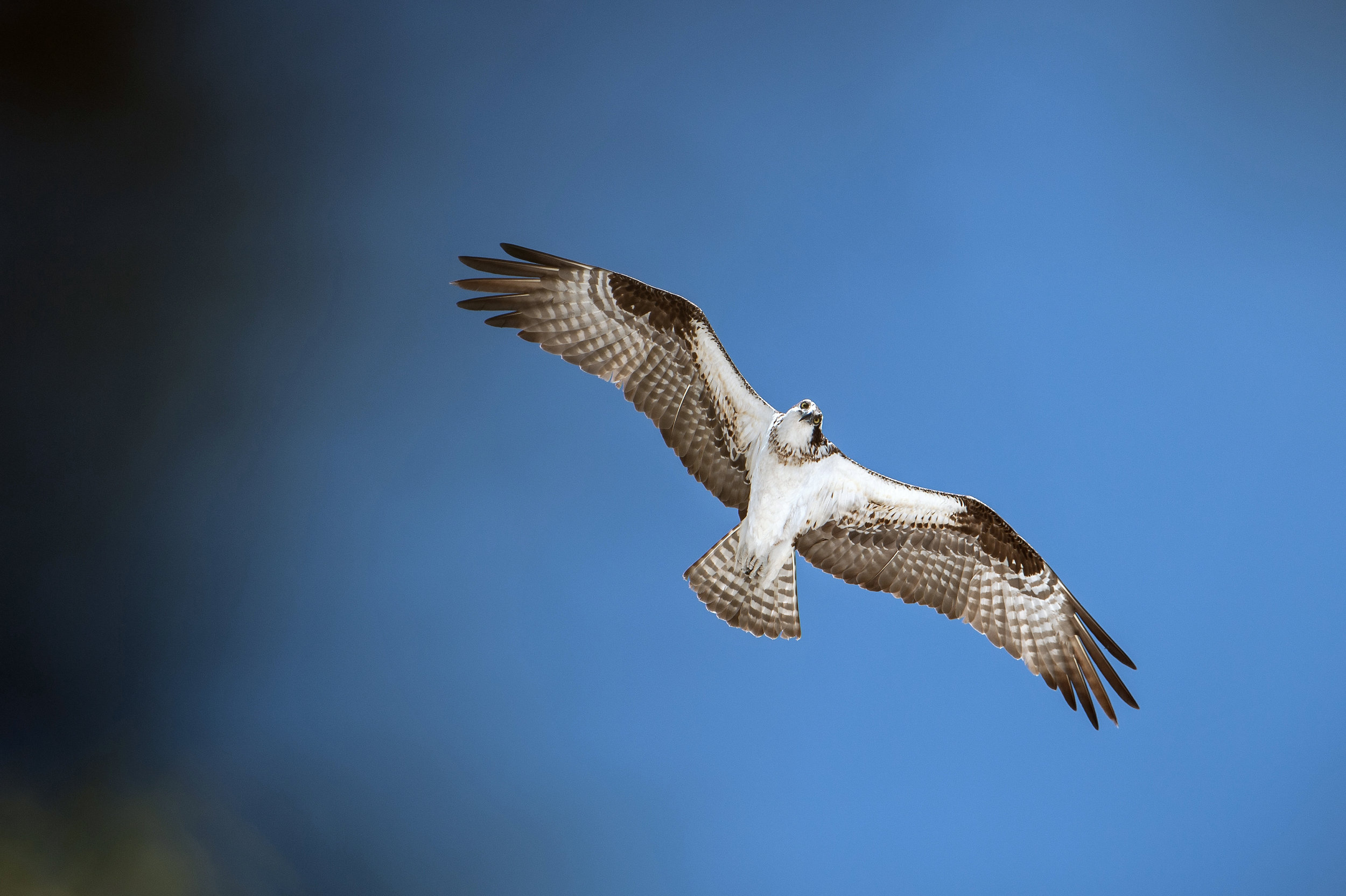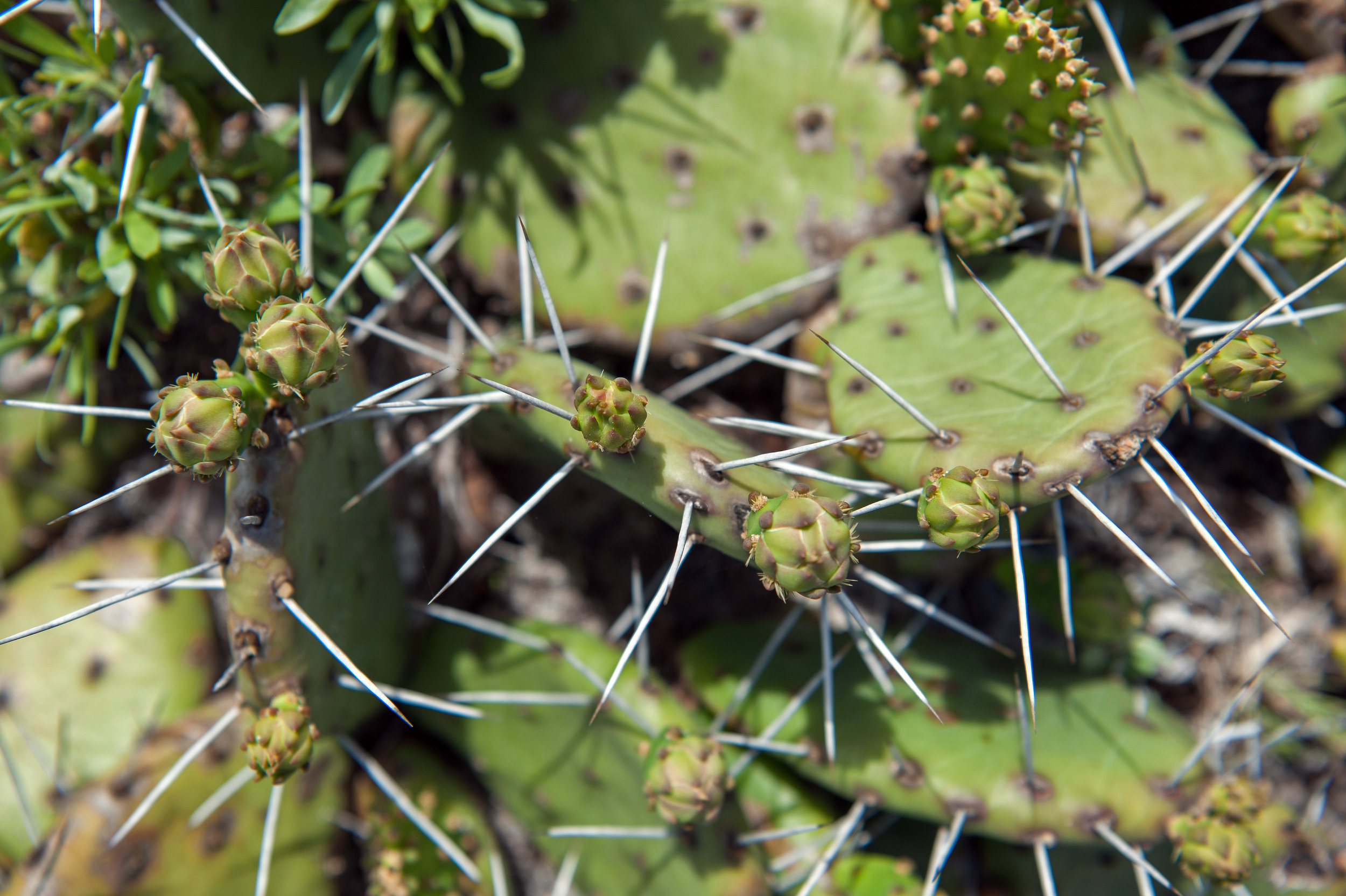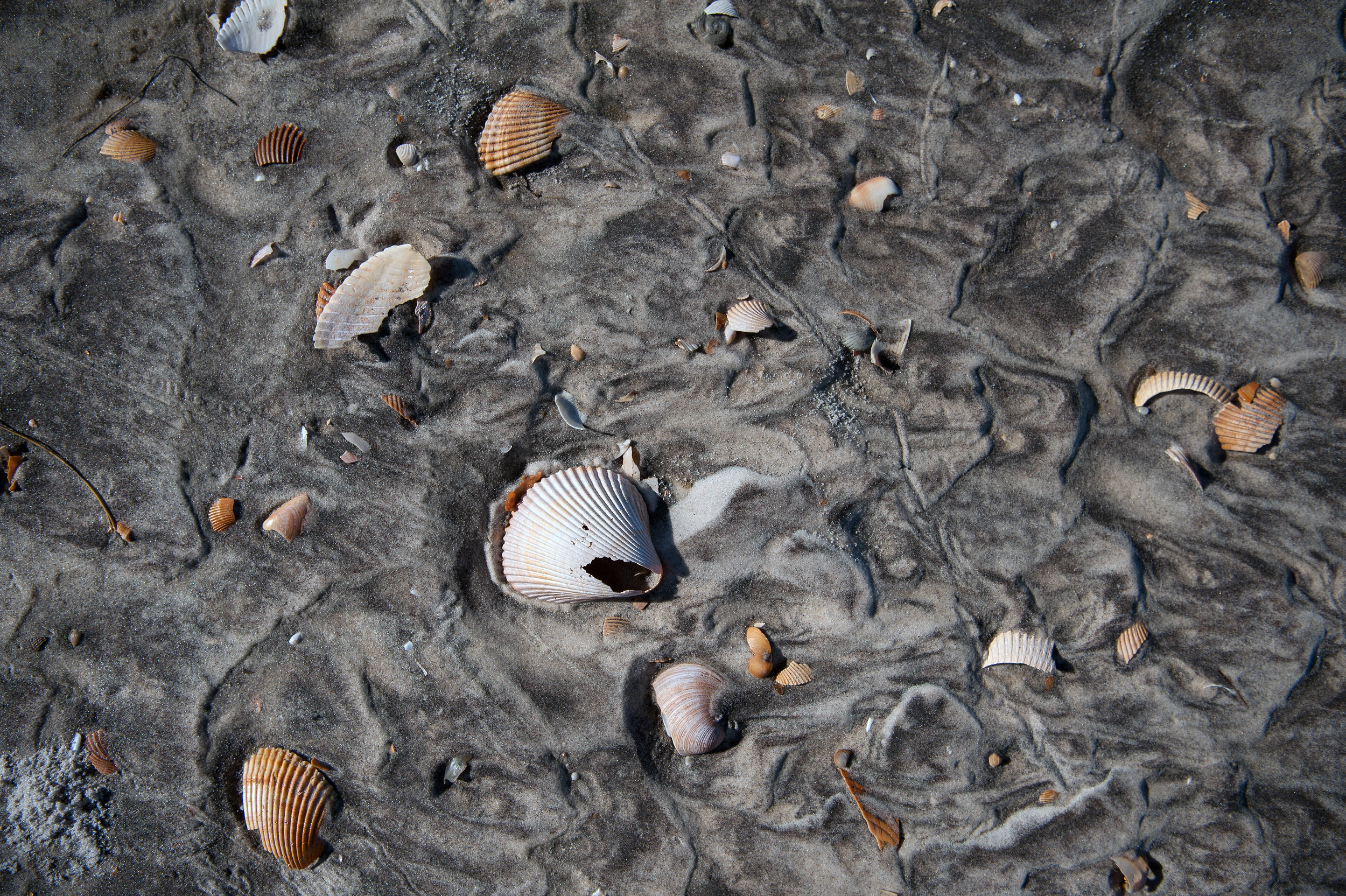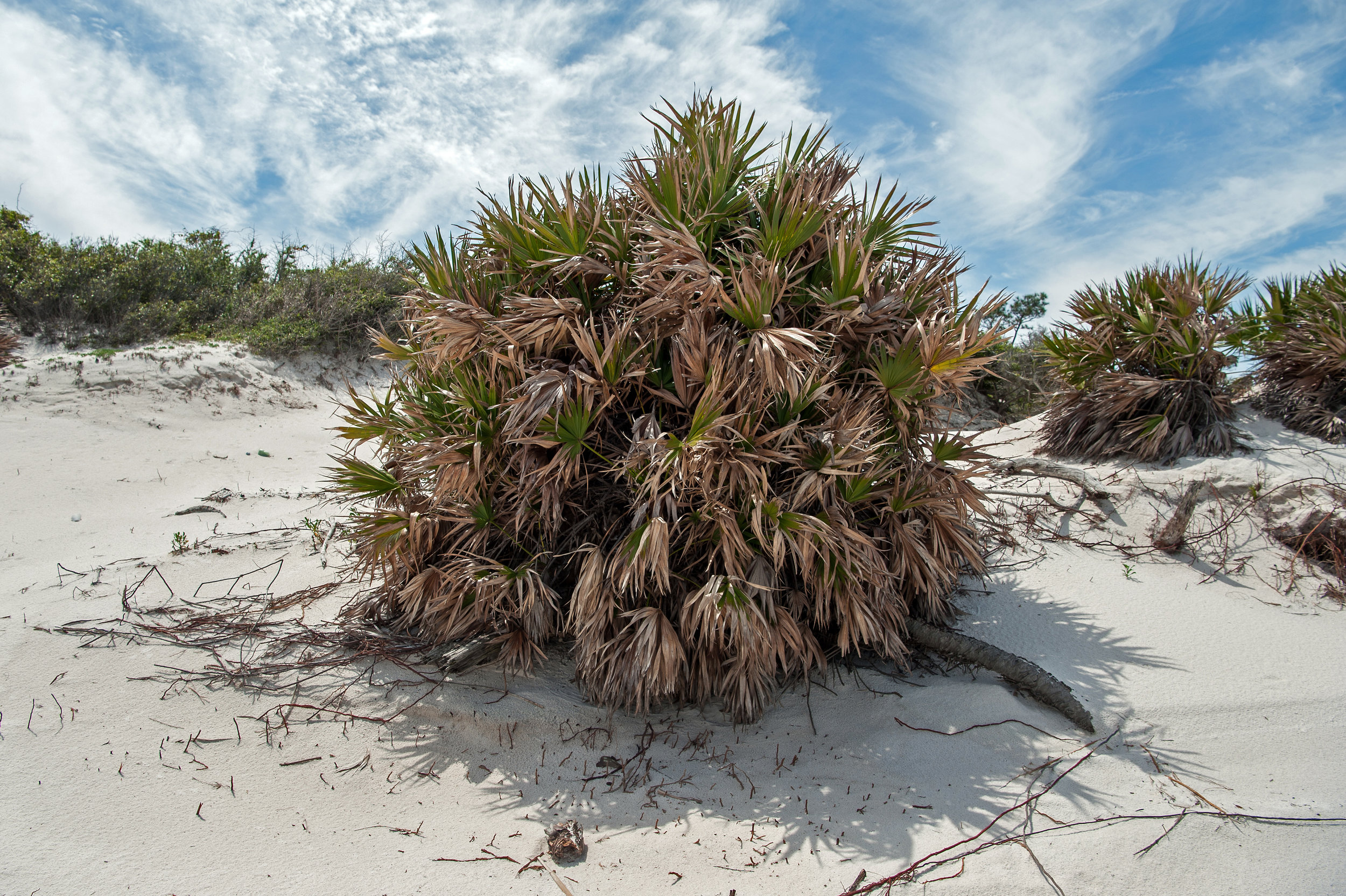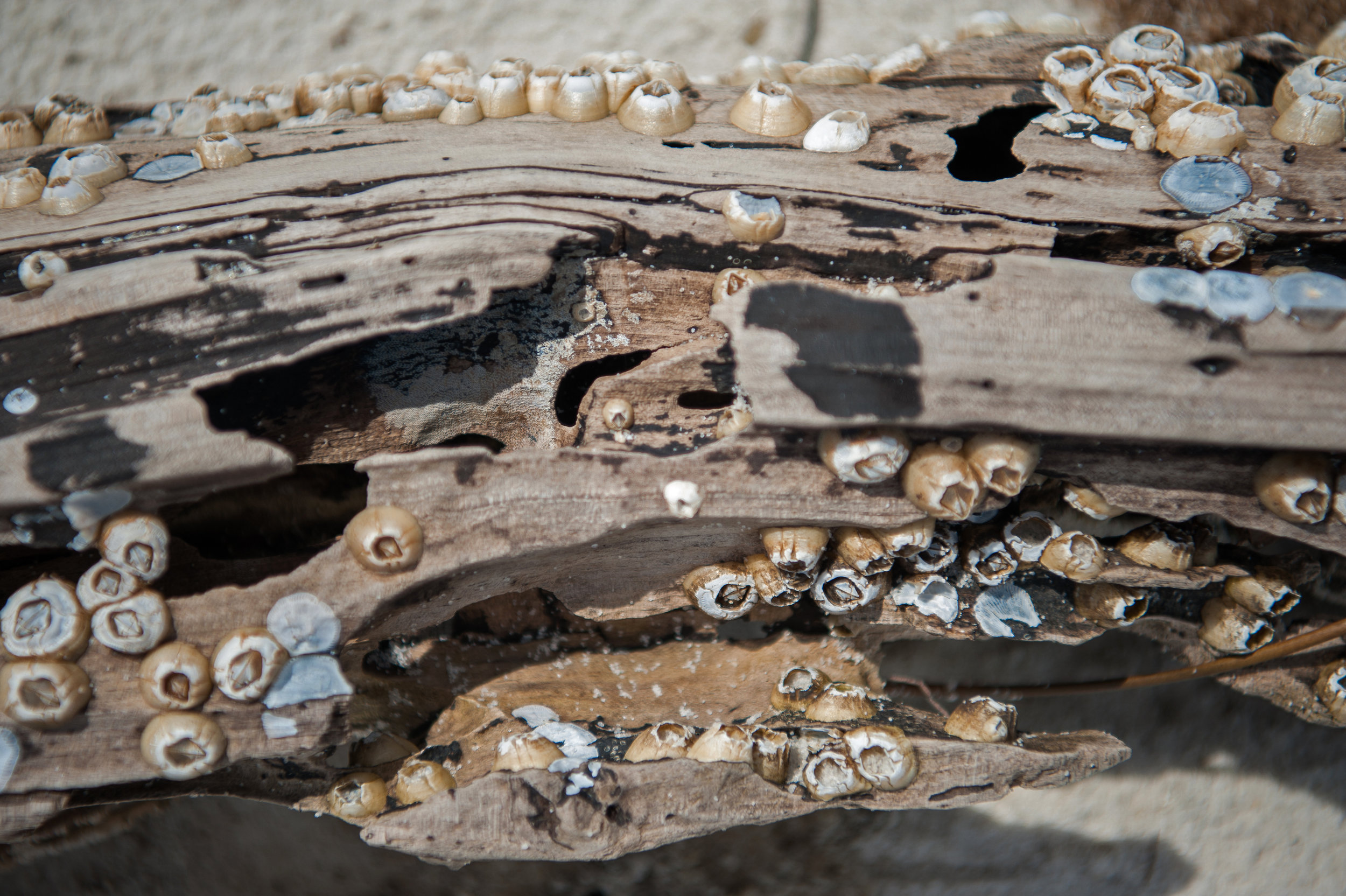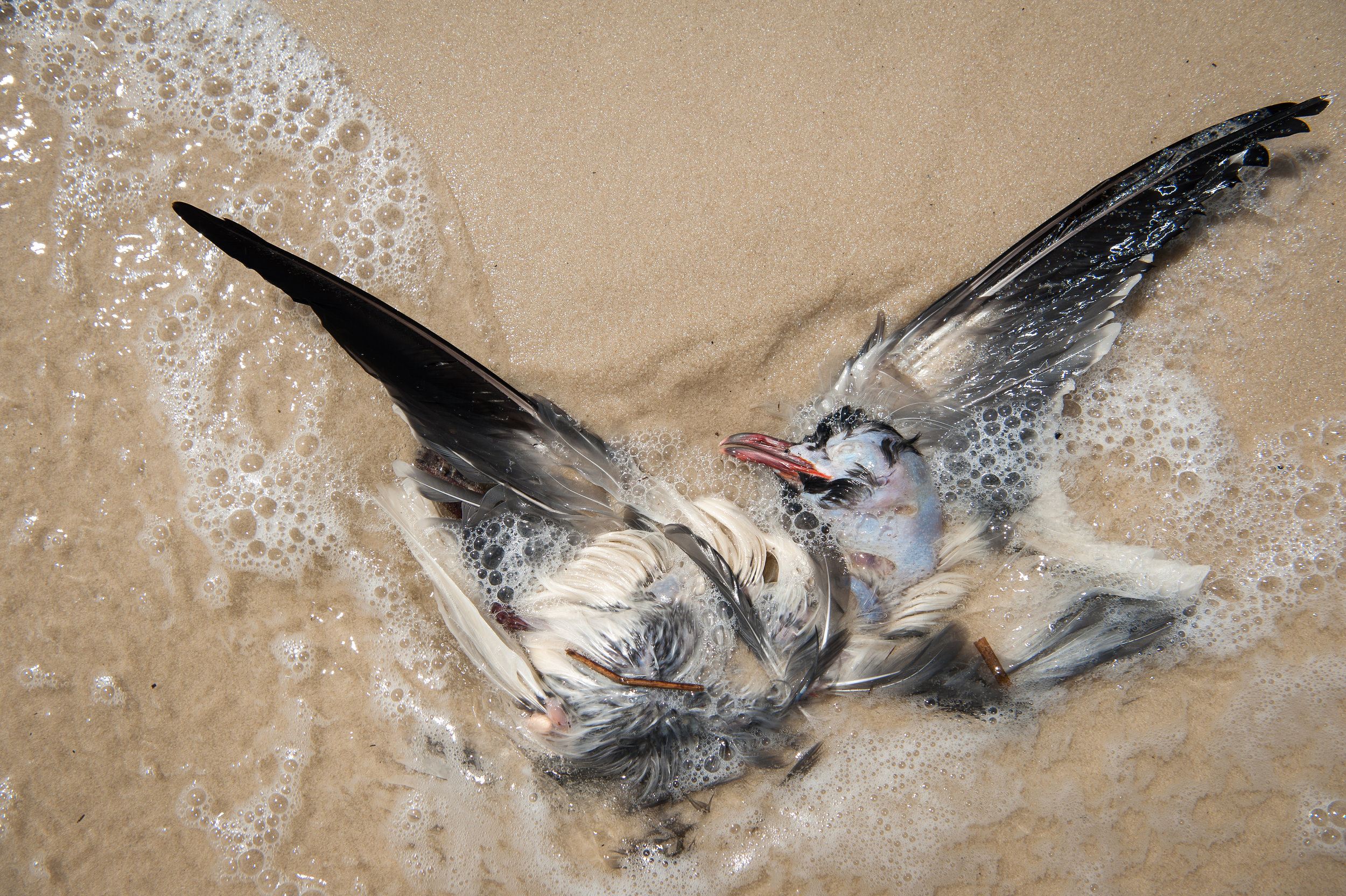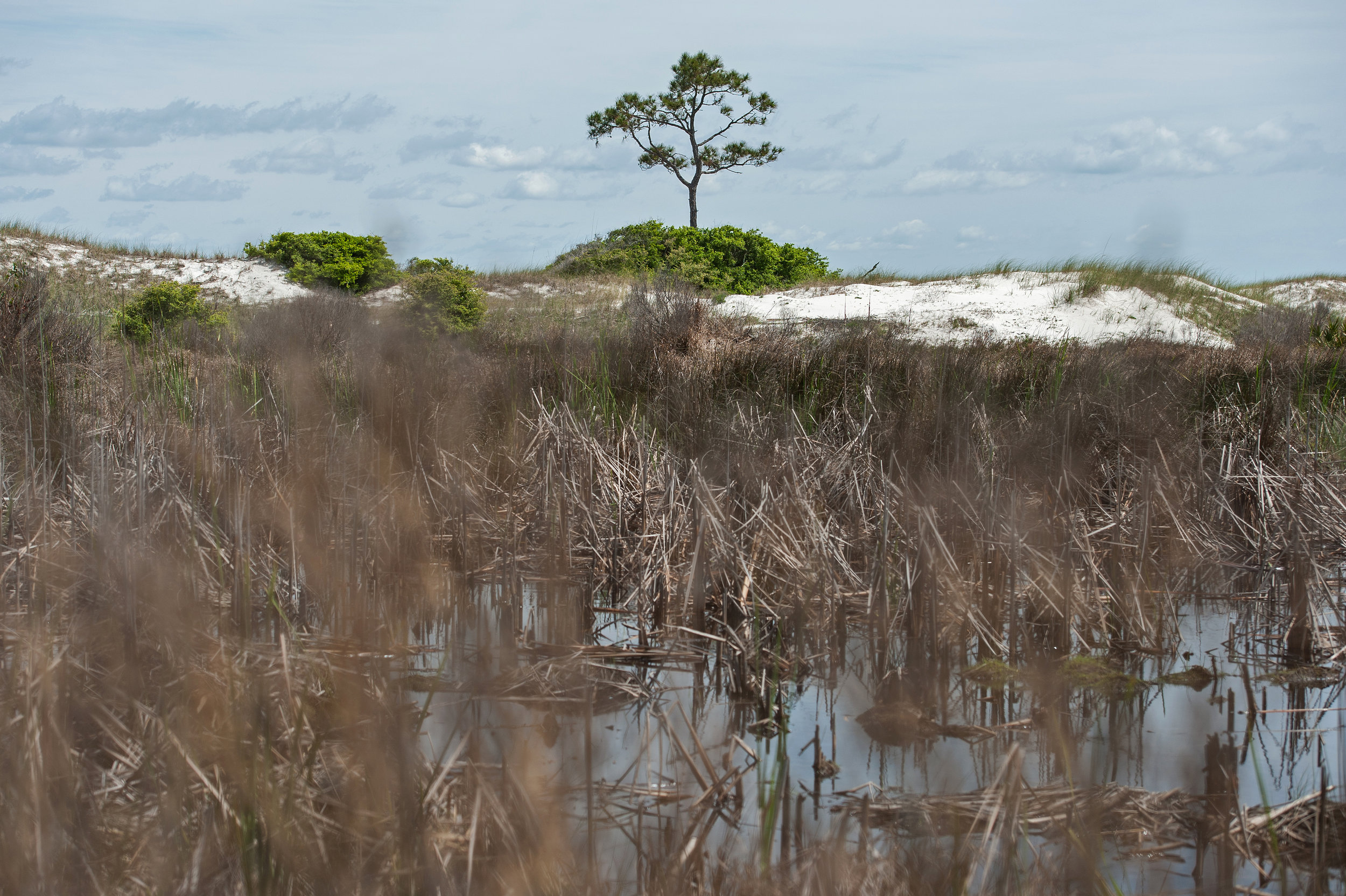Story by Boyce Upholt | Photos by Rory Doyle
In the Gulf of Mexico, five miles off the Mississippi coast, is a line of sand and trees and swamps known as Horn Island. Among its many virtues is its ever-changing light: the sky might be a harsh blaze at midday, then soft and wavering near sunset, until a moody blue arrives upon moonrise.
The painter Walter Anderson was drawn by that light. Wearing a battered old fedora, he rowed across the Mississippi Sound, then lugged his boat onto the island’s beach. He camped beneath that boat for weeks, dining on canned soup, crawling through marsh and mud to see that light. It drew him, he once told his wife, like a “physical craving, like hunger or sex, a necessity, a burning.” He painted constantly and quickly — watercolors on typing paper, the compositions loose-lined and alive with color.
Anderson launched his last voyage to Horn Island on September 1, 1965. His grown daughter was visiting, two months pregnant. But he must have felt that burning.
Nine days into his stay, Anderson woke to fierce winds. There was no rain, but the tide was rising — fast. He rushed to disassemble camp, then waded through chest-deep water that was rising into the island’s woods, dragging behind him his ten-foot boat, which he had tied to his waist. He eventually settled himself into the dunes facing the open Gulf. In his logbook from that voyage, he wrote that he slept well, sheltered by his overturned boat from the rains that soon raged.
That wind and rain was given a name: Betsy, the first hurricane in U.S. history to wreak a billion dollars in damage. The storm had “dignity,” Anderson wrote in his log. The next morning, he watched the tide wash over the ravaged beach.
“Never have I seen more ravishing jewelry than shone in the foam,” he wrote, describing the “thin broken pieces quivering with the slightest breath of air so that all the colors scintillated with the movement.”
But there was also what looked like “the remains of an all-night debauch”: trash and driftwood that had been carried from Louisiana; pine trees browned by the ocean’s salt. The spot where Anderson had made camp for decades was gone — washed away, he wrote. An old cow had lived on the island, the last remnant of its former use as a cattle farm, and she had been killed. When Anderson notes this fact in his logs, his heartbreak is evident.
In his notes about the storm, Anderson never mentions his family. Not his wife, who would often wake in the night, fearing her husband might have died. Not his visiting daughter, nor the granddaughter she carried in her womb, nor his other three children. They had called the Coast Guard, and Anderson had seen the cutter that was sent to rescue him, but he refused to reveal himself. The boat eventually left.
Anderson did not rush home. He stayed on the island for three more days after the storm had passed. When he finally returned, he had just a few words for his wife before he retired to his private cottage. By the next morning, he was gone again — wobbling on his bicycle the hundred miles towards New Orleans, adventuring again.
You will hear Walter Anderson’s name if you live in Mississippi — especially if, like me, you are drawn to wild places. He’s a kind of John Muir of the Gulf Coast, a Henry Thoreau of the South. Every year, travel stories appear in a handful of magazines, recounting visits to Anderson’s wild Horn Island.
A few years ago, I traveled to Ocean Springs, Mississippi, to research a travel story of my own. It was a simple piece, a guide to the city, and I visited the Walter Anderson Museum of Art mostly out of obligation. This was a prime local attraction, and it had to be mentioned.
The museum is built next to the town’s old community center, in which Anderson painted a mural in 1951. (He was paid $1 for the work, and hoped local children would assist, but he already had too much of a reputation as a “mad artist”; parents kept their kids away.) After I watched an introductory visit about his life, this was the first room I visited.
Anderson’s work has, in the words of a curator from the Smithsonian Institute, a “restless and impolite intensity,” and that is certainly true of the mural: With energetic strokes, in luminous color, Anderson conjured flora and fauna of the region — a great, swirling riot of life. There are humans in the painting, too: the first French colonists arriving by boat, the Native tribes that greeted them.
I found the mural absorbing, and I repeatedly circled the room. In response to a few recent losses — the death of my father; the flickering out of a six-year relationship — I had recently quit my job to write full time. My subject is almost always the wild beauty of the world, but I wasn’t sure I had anything new or meaningful to say. Anderson’s art offered affirmation, a lift to my broken heart: Here was just the kind of beauty I hoped one day to create.
Walter Anderson painted his Community Center mural directly onto the stucco walls, using oil paints. Its panels depict the history and wildlife of the region, including, on the west wall, some of the birds and trees he found on Horn Island.
I’d never bought an art book, but I decided I needed a copy of the coffee-table tome that summarizes Anderson’s career. I needed, too, the compilation of the logs that he’d kept of his journeys to Horn Island. When I asked in the gift shop about the books, I learned both were out of print.
Two of Anderson’s watercolors and two of his pen-and-ink drawings are in the collections of the Smithsonian Institute, along with microfilm copies of letters and sketchbooks. In 2003, the institute’s art museum hosted an Anderson exhibition, honoring the hundredth anniversary of his birth. In the decade and a half since, though, his genius has been widely forgotten. His work is idiosyncratic, hard to fit into familiar traditions. He painted quickly, often on cheap materials, and threw away as much or more than he kept.
One of the boats Anderson used to reach Horn Island is preserved (as is one of his bicycles) at the museum dedicated to his art in Ocean Springs, Mississippi. Also visible is a panel from an early mural, painted in 1934 at the local high school.
I left the gift shop with a copy of “Approaching the Magic Hour,” the memoir written by his wife, Agnes “Sissy” Grinstead Anderson. I read it quickly, in just a few days. The life she described was fascinating — and troubling.
When he was in art school in Philadelphia, Pennsylvania, Anderson preferred to travel home by ship, steaming down the Atlantic to New Orleans. Twice he canoed the Mississippi River. When he was invited to exhibit work in New York, instead of attending, he took off for China. To the end of his life, he’d ride his rickety bicycle on long trips. And, year after year, he would row his skiff to Horn Island, leaving his family behind.
Almost everything Anderson did in life was in an attempt to achieve what he called “realization” — to close the gap that separated him from nature. Anderson felt he could become one with a tree, a bird. Even with a rock.
He has been compared to Aldo Leopold, the scientist who is considered the forefather of modern ecology. Leopold talked about the importance of “thinking like a mountain” — considering the big picture, attending to the connections, situating ourselves appropriately within the web of life. Anderson, of course, had his own version: We could say he was always trying to think like an island. An island, though, is a place apart, separated by its waters. The irony of Walter Anderson’s life — its troubling lesson for those, like me, who aspire to stay connected with the wild world — is that his attempt to connect with the world turned him into a man entirely apart.
Born in New Orleans in 1903, Anderson was a “comical, adorable little ruffian,” as his mother once described him. As a 6-year-old, he would kick and punch when angry, but he knew precisely when sweet behavior was required. He became attached to the word “non,” which he spoke with the proper French accent.
“[I]f you ask him to come to you, he says non with impudence and decision,” his mother wrote. Young Anderson had a romantic inclination and would prance about with imagined swords and flags. “Bob,” as the family called him, grew into an adventurous child, an avid duck hunter who spent his school days sketching maps of the Louisiana swamps.
His father, George Walter Anderson, was a grain exporter, a wealthy man. His mother, Annette McConnell Anderson, was an art-school graduate, determined to make artists of her three sons. Her education had instilled in her a theory: If people surround themselves with beauty, the world will become a more beautiful place. In 1918, while Bob was at boarding school, Annette suddenly purchased a 24-acre tract on the Gulf in Ocean Springs, a small paradise of live oaks and sea marsh.
In 1920, Bob set sail from that property in a catboat, and at some point lost the tiller overboard. He dove into the ocean to retrieve it, and then watched as the current carried his boat away. He swam two miles to a post in the water, and he clung there, trying to hail the passing boats. Finally, after 28 hours, a fisherman rescued the boy. He surprised his mother in the sitting room in Ocean Springs. She had assumed he was dead.
Bob spent most of the 1920s in art school, first a year in New York studying commercial art, and then a more satisfying education at the Pennsylvania Academy of the Fine Arts. He distinguished himself with sketches of animals he observed at the Philadelphia Zoo, twice winning prizes. In 1925, he won his second prize and used the money to fund a formative trip: He set off hitchhiking through Pennsylvania, boosting his savings by painting portraits, and eventually joining a railroad work gang. Finally, he acquired a leaky canoe, which carried him down the Ohio and then the Mississippi River to New Orleans.
In 1927, he won a fellowship that sent him to Europe, where he was moved more by ancient French cave paintings than anything he encountered in museums. This was a breakthrough: As his wife later put it, he’d found art where the creator was a “part of nature instead of just observing.”
Meanwhile, at home, Walter’s older brother Peter had built a kiln and begun firing pottery. While Walter was traveling Europe, Peter, backed by their father’s money, had formally launched Shearwater Pottery. When Walter finished art school in 1928, he settled into this new family business, adding designs to his brother’s plates and vases. He later invented what he called “widgets,” a popular Shearwater product: ceramic figurines that depicted pirates, or — somewhat glaring now, in the hindsight of history — black Southerners engaged in old stereotypes, from “washwoman” to “chicken thief.”
For the rest of his life, his salary from Shearwater would form the bulk of his income — and his work there would eat up much his time. It was something of a frustration, and sometimes inspired a sense of failure. On his passport, in deference to his role at Shearwater, Anderson would always list his occupation as “decorator.”
On a spring afternoon in 1930, Agnes Grinstead — Sissy, as she was known to family — was napping in her family’s Gulf-side summer home. Just a few weeks earlier, her sister had married Peter Anderson. Now, her mother woke her and told her that her strange and moody brother-in-law was walking up the bluff to their house.
Walter “Bob” Anderson led Sissy on a walk. When they were out of sight of the house, he stopped suddenly and seized her in his arms.
“[T]hose arms were frightening in their hunger,” she later wrote.
Bob told her he loved her. “I have to have you,” he said. “Say you will marry me.”
The two had met the summer prior while their siblings were courting. The Andersons and Grinsteads had shared many fine afternoons — swimming and picnicking, rambling down country roads by car, up bayous by boat. The three Anderson brothers seemed always to be breaking out in song.
Now, Sissy’s heart pounded in her chest. She’d thought nothing of love. She hadn’t felt a thing.
So, she fled his embrace. When Bob caught her again, she promised she’d consider his proposal. The two sat by a pond, smoking hand-rolled cigarettes and watching dragonflies. Then Sissy smelled burning flesh. Bob had pressed out his cigarette into his palm.
“A terrible shiver of wonder went through me,” she wrote in her memoir.
Thus began their strange courtship. One evening, as they lay on the bank of the Pascagoula River, Bob asked her why she feared the dark. She didn’t fear the dark, she insisted — and then reached out to discover that he was gone. She stumbled into the night, seeking the path home. As she passed through a cemetery, she fell into an open grave. Finally, Walter reappeared, apologizing in a trembling voice. Sissy later decided this symbolized their long relationship: It was “Bob wanting desperately to give me his sense of wholeness in the universe, to strip away my fears and make me see with my whole being, to give me inner light,” she wrote. It strikes me as a harrowing sort of love.
At the end of the summer, Sissy returned to Boston (she was a senior at Radcliffe College) and fended off a series of pleading letters. She was drawn to Bob’s passion, but worried by his willingness to destroy himself. In her memoirs, she wrote that she consented to the engagement under a kind of duress: Bob had said he’d drown himself if she said no. Soon after she graduated, she allowed Bob to ask her father for permission. Her father agreed, reluctantly, but the wedding had to wait two more years, until 1933, when Bob’s finances reached a steadier state.
The new couple moved into a cottage on the Shearwater property, outfitted with furniture Anderson built himself. It was not always easy for Sissy, with her sharp intellect, to subordinate herself to her artist husband, but it was a pleasant life. They would sail on the Gulf; they would wake in the morning and turn on the record player, luxuriating in concertos by Bach.
The cottage where the Andersons began their marriage — and where Walter Anderson spent his final years — was built in 1850, likely as quarters for enslaved laborers. Anderson added his own built-in furniture. Severely damaged by Hurricane Katrina, it was restored in 2012.
In 1934, the Andersons took a perfectly idiosyncratic honeymoon: They traveled north to attend a Bach festival and visit with Sissy’s family, then paddled home down the Mississippi River. One afternoon, amid a thunderstorm, Bob stripped naked and danced on the wet sand. But in the Mississippi Delta, he grew ill with malaria. They abandoned the trip, taking a bus home.
The canoe — brand new, beautiful — was shipped behind them, and when it arrived, Bob left it in a fishing camp. It was never used again and eventually disappeared beneath the water. Sissy supposed he was saddened by that trip: On his first voyage down the river, Anderson had been young and free; now he found himself wed and working. He never mentioned the trip in her presence again.
John Anderson, the couple’s youngest son, believes the trip was responsible for the worst of the coming days: Severe cases of cerebral malaria have been associated with a wide range of psychological symptoms, including some of the behaviors Bob soon displayed.
In 1937, a month after their father’s death, Peter Anderson found Bob gripping two razors, mumbling. To Sissy, Bob would first express a strong desire for sex and then a conviction that he was diseased and impotent. Sissy writes in her memoir that after a suicide attempt, Bob began to rave.
“Who is my God?” he asked her. “Is it my father who is dead?” He dropped to knees and began to walk like a cat.
“Is it the cat of your dreams?” he said.
He shouted about spirals — the way spirals curl in the other direction below the equator, and how his God was a spiral, with no beginning and no end. Then he sat on the floor, crying, and said he was searching for more gods.
The family arranged for Bob’s admission to a psychiatric clinic in Baltimore. His eighteen-month treatment there meant that he missed the birth of his first child.
When he returned home, Bob lived alone in his studio, often complaining that Mary, his new daughter, was the result of some affair by his wife. (There is no evidence to suggest this is true.) He claimed once he wanted to crucify the girl. On another occasion, he brought a blanket to her crib and began to smother her.
Within four months, Anderson was back in a hospital, this time Mississippi’s state psychiatric ward. Another two months later, he had escaped: He tied a rope of bedsheets and lowered himself three floors to the ground. He paused on the way down to leave behind his art: a great mural of birds in flight, rubbed onto the red brick with soap. The remaining patients stood before it in awe.
Two weeks later, he was found sleeping on the springs of a mattress-less bed in his studio. The family sent him to another hospital in Baltimore, which managed to hold him for two months. This time, his journey home required a walk of more than a thousand miles and took three months. The family believed he followed rail lines south. On all of his journeys, Bob had kept a logbook, and this time was no exception. He’d made drawings on scraps of discarded paper and tied them together with scavenged string.
He simply could not be held. (“Daddy was the wildest nature, ridiculously unsuited to confinement,” his youngest daughter, Leif, later wrote.) When he was hospitalized in Mississippi again, he quickly escaped, then escaped again from his mother’s care in a cottage in Jackson.
Today, Shearwater Pottery is owned by four of Walter Anderson’s nieces and nephews, the children of Peter Anderson, its founder and first potter. Three of the children are still active in the production of its pottery.
A second child, a son named Billy, was born just after Anderson’s thousand-mile walk. Sissy tried to separate, leaving Ocean Springs with the two children. They stayed with friends and family in Chicago and then Biloxi. Bob always followed. When he appeared, unannounced, in Chicago, a feeling of “belonging” swept over Sissy, she wrote.
Bob promised that he was cured. But at home on the coast, he pressed Sissy for sex, sometimes over her objections. (After it was over, he would punish himself, as he had upon the night of his first proposal, by burning his flesh.) One day, he hurled a knife at his wife and daughter. Sissy contemplated divorce, but instead decided to move again—with Bob this time, trying to build the kind of life in which he might thrive. Bob had always said he thought manual labor—perhaps farming—could be what would save him. So Sissy decided to return to Oldfields, her family’s summer home.
“I’ve bought a car and a cow,” she told him. “I’m going back to the land. Would you like to come?”
Christopher Maurer, Anderson’s biographer, calls the near-decade that Anderson spent at Oldfields “his only prolonged experience of family life.” Finally, the painter seemed to settle into place.
During his hospitalization, drawing had been an outlet, and at Oldfields Bob became even more productive. He illustrated poems Sissy had written, as well as famous epics — voyages, often, like “The Iliad” and “The Rime of the Ancient Mariner” and Charles Darwin’s logs. Studying texts on symmetry and design, he began to develop his now-trademark style.
He was a father, if an unconventional one: He took the children swimming, teaching them to blow bubbles on the water’s surface so the fish would come nibble at their mouths. He gave gifts of hand-made dolls and put on elaborate puppet shows. Two more children were born — a daughter, Leif, in 1944, and a son, John, in 1947 — though Anderson never attended a birth.
He wandered, of course. By bicycle, he traveled to New Orleans to sketch city life, and crossed the Texas desert, even journeyed up to New York to visit museums. He traveled to Costa Rica to paint wildlife. He walked and sailed the Gulf Coast and its bayous in search of birds. Water had always been important to him, and he called certain bayous and ponds his “nullahs,” places where he could submerge himself and be spiritually refreshed.
“Far places are connected with truths,” he once told Sissy. “I have been very far, farther than the farthest star.”
Anderson spent his “family years” at Oldfields, an 1845 Gulf-side house that belonged to his wife’s family. It was once part of a sprawling, 22,000-acre property, but is now surrounded by suburban development. The house suffered severe damage in Hurricane Katrina, and disputes over its ownership have made restoration difficult.
John Anderson, Walter’s youngest son, believes his father spent these years at Oldfields seeking sanity — assembling his own sense of reality, one that would be safe from the adversities he had experienced before.
The logbooks from his journeys can be dull at times, simple recitations of his day’s activities. But occasionally they’ll sparkle with wisdom. John has picked one aphorism as his father’s most important: “In order to realize the beauty of humanity we must realize our relation to nature.”
The idea of “realization” has become central to the contemporary understanding of Anderson, though just what the word means is not always clear. Sissy, in her memoir, wrote that realization was a process by which Bob “could become one with tree or insect or any living thing.” (His kinship for the nonhuman world could reach extremes. Once, Sissy caught him spoon-feeding sweetened coffee to a cockroach. “They have lived upon the Earth's surface far longer than we have and are due a little respect,” he said. “Besides, this one is my friend, and particularly intelligent.”)
Another scrap from his logs has colored interpretations of the word: “Order is here but it needs realizing,” Anderson wrote from Horn Island. Some scholars believe this sentence implies that nature depends on humanity. The natural world “cannot be entirely ‘itself’ without the intervention of the artist,” writes Maurer, in the introduction to his biography, “Fortune’s Favorite Child: The Uneasy Life of Walter Anderson.”
When I encountered this interpretation, it rankled; what first drew me to Anderson’s art was its obvious humility. The world he drew was self-fulfilled — a place we might marvel at, and marvel at our place within, but whose beauty was already complete. Anderson’s artistry only deepened and extended that beauty. It was an act of noticing, a kind of mindfulness, and a gift to the viewer, too, a reminder we can just as easily notice beauty.
John Anderson, pictured in his father’s restored cottage, has become the spokesperson for the painter’s philosophy. A 10-day stay on Horn Island helped him realize Walter Anderson’s travels were inspired by love — love for the island, for his family, and for all of humanity.
When John Anderson and I spoke — in his father’s cottage, which seemed alive with Walter’s ghost — he told me that Mauer’s interpretation was “bullshit.”
“Nature doesn’t need us,” he said. “We need nature.”
Maurer, he said, hadn’t spent enough time in nature, and that made it hard for him to grasp the painter’s insights. John is troubled by the biography in other ways, too, enough so that he required that he be allowed to write a rebuttal of its psychological assessments. Maurer, for his part, writes in the book that he does not intend to diagnose the artist, but simply present the diagnoses for the historical record.
The word “realization,” John believes, should be taken literally: It means “making something part of your reality that was not part of your reality before.” His father, he told me, was “talking about reaching beyond the veil, into the unknown, seizing something that you know is true — and you grab it, and you pull it back into your reality. That’s realization. You’re making something real that was not real.”
John’s interpretation depends on an unusual concept of “reality.” Yes, there are empirical facts out there, John believes — these are what his father sought as he sifted through the shells on the beaches of Horn Island, or climbed its trees to examine the shapes of the birds’ nests — but these empirical facts are not reality. The reality we experience is mediated; each human being orders and interprets his or her experience in the world. We each construct our own reality, then, and the truth beyond our constructions can never be reached — only pursued, endlessly.
The mores of society are built upon a collective, consensual interpretation of the world — one most people accept without examination. This is not reality, Anderson noted in his log, but, rather “the sordid thing most people call reality.” He told his wife that he did not want to be “that kind of normal.”
“I must be in harmony with this…,” he said. As he spoke to her, he gestured with his hands toward the surrounding world. “Not only must I be in harmony, I must make it manifest.”
For Walter, it seems, harmony required separation. Sometime around 1947 — the year John Anderson was born — Walter abandoned Oldfields and returned to the cottage at Shearwater where the couple had first lived.
Anderson wrote that what most people call happiness is just “loss of consciousness.” What others considered unhappiness he saw as a vital part of his life: his ability to see.
He was still drawn to Sissy. He would ride his bicycle to Oldfields in the darkness — over 15 miles of narrow, two-lane roads — and stay with Sissy a part of the night, disappearing before dawn. The family eventually followed him to Ocean Springs, settling into what they called “the Barn,” a building just down the road from Bob’s cottage, on the Shearwater property. (Like many of the family homes at Shearwater, and much of Anderson’s art, the Barn was irreparably damaged by Hurricane Katrina.) Sissy, to pay the bills, took a job as a teacher.
The children looked at their father’s cottage as a wild place, shrouded in azalea bushes and thorny Cherokee roses. Strange sounds emerged, “loud music and louder stompings of his feet,” Leif writes in her memoir. “It could mean a drunken frenzy, and everyone silently prayed he would stay where he was.” When Anderson took off on his adventures, the family would mostly feel relief, Leif writes. “For a while life would be more relaxed, less inclined towards watchful nervousness. One could play with abandon; no fear of sudden encounters. Sleep would be deeper, more peaceful.”
Anderson would give gifts at Christmas, odd gifts: pens or flashlights, or used books. These were signed not from “Daddy,” but from “Bob.” The family sometimes hosted soirees, and Bob would attend.
“[H]e almost looked real,” Leif writes. “I mean like someone’s father reading bedtime stories to his children. Drowsiness made me feel safe and sort of normal. But he never was there the next morning.” In 1951, as Anderson painted the community-center mural that so moved me, Leif attended dance lessons in the same room. She could never tell if he was aware of her presence there.
But his reputation as an artist was beginning to grow. In 1948, at the behest of two longtime Shearwater customers, his work was shown in Memphis. Purchased pieces made their way to Brooklyn. Later that year a letter arrived: The Brooklyn Museum wanted to host an exhibition of its own. Anderson agreed, though he expressed a hope the work might be priced cheaply enough for the masses. He wanted it available to anyone with “an appetite for beauty and the imaginative world of fairy tales,” he said in his reply.
Anderson never attended the exhibition himself. Instead, he took off for China. According to Leif, he never told the family about his intentions.
“He just left a scrap of paper attached to his screen porch door,” she writes.
John believes Walter wanted to avoid recognition and accolades, which would only limit his hard-earned freedom, only dilute his ability to see. John also believes his father wanted — “desperately” — to find people who shared his hard-won vision of reality. Tibet, with its tradition of Buddhism, appealed.
The trip was ill-fated. One night, camped in rural China, Anderson woke to find his possessions missing: his money and passports, and — even more dismayingly, I’d guess — his paintings and logbook. Anderson had to wire his mother for money to fly home, then sort out a morass of visa and passport issues. He never made it to Tibet.
But Horn Island and its solitude offered comfort. He had known this island for most of his life; in their early courtship, he had suggested to Sissy that they build a drifters’ life there. After the Oldfields years, it became not their place but his alone. For the next 15 years of his life, it became the central focus of his travels.
He liked to row there, leaving at sundown, under bursting pastel skies that turned as he traveled into thick, still darkness. When fishermen passed and offered rides, he refused — their boats were too fast, too loud. He’d pole through the shallow waters, sail with an unfurled blanket when the winds were in his favor, swim to tow his boat when he got swamped. After six hours or more, he’d arrive on the island. He napped through the morning, waking to the glare of the afternoon.
“Going home,” he called these trips.
The island is about 4,500 years old, and, like other nearby barrier islands, is the creation of the slowing Gulf current as it arrives near shore; as the water stills, it drops its sand. The Gulf’s barrier islands are ever-shifting places; the tides wear away their eastern tips and deposit smaller amounts of sand on the western side. In the late 18th century, a geographer measured Horn Island at 17 miles; now, it is about 10 miles long.
Such small islands have never played large roles in human civilization, and their size means they rarely host true ecological abundance. But, perhaps for those very same reasons, such spaces have always captured the human imagination. Many early societies envisioned paradise as an island; the buffer of water kept the wolves at bay. By Anderson’s day, of course, the pleasures offered by an island paradise had inverted: He loved the island not because it separated him from wilderness, but because it placed him within wilderness, and protected him from the human world. It was a place, as Anderson famously put it, where he could forget the “dominant mode ashore.”
Anderson certainly suffered the rigors of the island. There were swarms of mosquitoes and sand flies, brutal heat in summer evenings, lashing storms. The water teemed with jellyfish, and the island was thick with cottonmouth snakes. In 1962, he was bitten as he reached up to examine a bittern’s nest. He passed out on the beach, surviving only because he was rescued by two boys passing in a boat.
But to the modern wilderness lover, Anderson’s life on Horn Island mostly sounds like a dream: sipping fresh-brewed coffee beneath his overturned boat, sleeping beneath stars. He provisioned himself with random cans of food, and their labels were always washed away by the seawater, so he was never quite sure what he would find inside. He drew his water from an artesian spring. Days became long meditations, wandering about the island according to whim, contemplating the bounty that nature provided. He collected animals, sometimes naming them, to serve as models for his art. He wandered the deep pine woods and acres of scrubby holly and wax myrtle. He waded through the island’s lagoons.
In his logs, Anderson once complained that a human being too often begins “by saying ‘of course,’ before any of his senses have a chance to come to his aid with wonder and surprise. The result is that he dies and his neighbors and friends murmur with the wind, ‘of course.’” The cure, Anderson believed, was to pay attention to those senses, and to the beauty in the world: “The love of bird or shell which might have restored his life flies away, carried by the same wind which has destroyed him.”
On the island, he painted thousands of watercolors — of birds and shells, of cows and rabbits and trees. They are at once realistic and impressionistic, capturing the formal beauty of the island’s ecosystem in pastels and dark blues — not the colors you associate with these animals in, say, a child’s bestiary, but once you see the pictures, you know that he’s perfectly captured the beachside light. The images radiate with ephemeral energy, and there is a sense of humility, a willingness to set aside preconceived notions and find what’s there. Even the “ancient head” of a cottonmouth held a “formidable beauty,” Anderson wrote in his log — a beauty he paused to paint. (No surprise, then, he wound up snakebit.)
He believed these animals have an easier time realizing their relationship with nature.
“The animal always does the wise thing, because he has no choice,” John explains, paraphrasing a line of his father’s. “Man seldom does, because the ego gets in the way.”
John, to show what he means, conjures an image he remembered from his own voyages to Horn Island: a squadron of pelicans, spiraling above the water. The pelicans would “scintillate,” he says, an effect of the sun shining first on their white bodies and then their dark wings.
“When the sun shines on the dark, they disappear,” he says. “When the sun shines on the white, they appear — they reappear. It’s almost a suggested spiral, an intimated spiral.” The pelicans were realizing their relation with nature, he said, and so they were beautiful.
“God, we’re so small,” John murmurs as he envisions the pelicans. It is an aside, and it feels like he is speaking to himself, reflexively, beyond ego. “We’re so small.” I’d seen pelicans in my own travels, dancing this dance, and I could not help but agree.
It’s important to note that Anderson’s status as a genius largely came after his death. In his island years, he rarely shared his paintings. To his neighbors in his small, Southern town, he was an odd creature, the “town fool,” John Anderson tells me — always rumbling around on his rickety bicycle, doffing his hat to the ladies, as if he were Don Quixote, a character he loved.
Many in town called him the “Horn Island Hermit.” That snakebite, which nearly killed him, became a joke, revealing the artist’s reputation as a man halfway feared. “A moccasin bit Walter Anderson,” the joke went, “ — and the moccasin lived!”
To John Anderson, such jokes stung. “You don’t like hearing jokes about your Daddy, which make fun of his near-death experiences,” he says. But John admits he shirked his father, too. If he was hanging out downtown with friends, and his father came past, John would turn around and pretend not to notice.
Then, when John was 18, Walter Anderson died.
“Within less than five years, he was one of the most celebrated artists in the South,” John says. “That’s a pretty big adjustment.”
As he grappled with the death, he asked his mother who Walter Anderson really was.
“And her response was that he was an explorer and a shaman and a teacher. When she saw the blank look on my face, she said, ‘Maybe you’d better get out to Horn Island.’ I listened. I always listen to my mother; she is the most brilliant woman I’ve ever met. So, within a very short time, a couple months, I was on a small sailboat, pushing out in the wash at three or four o’clock in the morning, to take advantage of the sea breeze.” John spent 10 days on the island. The island changed his life.
He eventually decided his father loved the family deeply. After his parents split, Bob was the one on the bicycle, braving the highway to see his wife. He was always there, always watching. As a child, John loved a cat who wandered the Shearwater property, a fact he kept hidden lest he be deemed unmanly. After his father’s death, among his paintings, John found an image of a boy and a cat. His father had watched him, he realized; his father had known him as he was in his most guarded moments.
“He was here, always available to his children,” John says, “if they had wanted him.”
John believes it was the family, in part, that drove Anderson to Horn Island.
“You have to put yourself in his shoes,” he explains: His family is embarrassed by him; by leaving, he gave them what they’d wanted. “If he goes to Horn Island, he’s not being subjected to the friction between his love and their lack of love.”
John has found a kind of acceptance in this paradox. Hardship creates beauty; his father’s isolation was a necessary precursor to his wisdom and art. If Walter Anderson’s family had been more supportive, he might never have left for Horn Island — and without Horn Island, he would not have plumbed the same depths. Think, then, of the beauty the world would have missed.
After my own father died, I learned he too had been diagnosed with mental illness. I still don’t know the label he was assigned, nor do I care to. Suffice to say he was an unusually quiet man, one who seemed to stand halfway apart from the world. When we were alone together — in the car, at meals — neither of us knew quite what to say.
Still, I had found his quiet instructive. He was a traveler, a scientist, an activist. A man of conviction, I like to think — someone who voyaged, in his way, beyond the farthest stars. But for some people — my mother, for instance — his distance could cause pain. For her, diagnosis brought relief. There were difficulties in my family I had never sensed.
I’m quiet, too. I’ve been told that at times my emotions can be hard to read. I have many friends, but few who are truly close. I credit much of who I am to my father, but perhaps I inherited some of his distance, too. I sometimes wonder how long I will spend wandering — from relationship to relationship, from town to town, and home to home.
Since I first saw Walter Anderson’s mural, I had planned to visit Horn Island. But it took me months to make the trip. Hurricanes, freezing weather, busted boat motors — everytime plans seemed to be coming together, some obstacle would arrive. Finally, the Thursday before Easter weekend, along with my friend and frequent collaborator Rory Doyle, I got in the car and drove south. We called and texted friends as we rolled toward the coast, attempting to secure a ride.
By Friday morning, we were aboard a speedboat piloted by chef Matt Mayfield, co-owner of Tay’s Barbecue, a friend of a friend and a devotee of Horn Island. Mayfield was happy for an excuse for an early-season scouting. He skimmed us along Horn’s northern border, pointing out landmarks and trails. Then, he picked a suitable beach, anchored in the shallow water, and sent us wading into the chop. Before he departed, he passed over a gift of smoked-tuna dip and an oyster bag filled with iced beers. He wished us luck, then turned back toward land, marooning us there. We were alone: nothing but sand and trees and water in sight.
In the weeks before the trip, I had published a short story that had garnered surprising attention; a well-connected agent had asked to see more writing, as did an editor of a major magazine. I felt on the cusp of a new kind of success. But as I sent pages, and talked of my other projects, their interest seemed to fizzle. Then I turned in one of the biggest assignments of my career, and the magazine made clear that my draft was lacking. From excited mania, I slipped into a depressive period. I understood Walter Anderson’s inclination to call himself a decorator; I felt less like a writer and more like someone who was awkwardly rearranging words.
It was a relief, then, to spend the weekend swimming and cooking over driftwood fires and, more than anything, wandering — 10 or more miles each day, walking up and down the dunes. The center of the island is filled with wetland valleys — marsh grass and water and alligators — but John had drawn a map of the dry crossings that link the northern and southern beaches. In dry stands, we found prickly-pear cacti and slash pines. Often, we came across the remnants of salt-killed trees, which stand straight and barren like the posts of ancient structures, as if a forgotten civilization had once claimed this land.
Through the years, the island has had its residents, though the shifting dunes have erased most signs of their stays. In the late 18th century, a keeper tended a lighthouse, which was destroyed in a storm in 1906. For the next two decades, a family raised cows and pigs.
The island turned nearly urban for three years during World War II, when the U.S. Army set up camp. They built barracks that could house 200 soldiers, and set up a movie theater, a basketball court, a mess hall, a machine shop. Sewage lines were installed, as was a power plant. The camp’s grim business was indicated by a brick chimney: Here the animal subjects of its biological tests were burned after their death. They were subjected to bombs filled with botulinum, the toxin that causes botulism.
Anderson avoided the island in those years, though he washed ashore once after overturning his boat on the way to a nearby island chain. When he heard the moan of a train — an impossibility — he knew he had lost consciousness. But then a guard dog and its keeper seized him, and he became a rare visitor to the Army’s camp. He discovered that an eight-mile train line had been constructed, for carting materials across the island.
While he was interrogated, Anderson swelled with rage.
“You have ruined the most beautiful place in the world,” he said.
His interrogators defended themselves, claiming that their studies were essential to the war effort. This proved overly hopeful: The bio-bombs were failures, and only one animal, a guinea pig, ever succumbed to the toxin. In 1947, the Army abandoned the camp. Before they left, they set a bonfire that popped and crackled for days — their shortcut method of disposing of 3,000 tons of seized German munitions. (Some bombs were dumped into the sea, a secret that was kept for years.) Three years later, Anderson briefly sheltered in the ruins of the camp, but he must have decided he preferred a bed of sand. He eventually settled into a few seasonal camps on the northern shore of the island.
In 1971, just six years after Anderson’s death, Congress authorized the creation of the Gulf Islands National Seashore, under the care of the National Park Service. The seashore includes Horn Island. At one point, plans were developed to pave the island’s crossings and develop a hundred-acre campground. In 1978, though, Horn Island was declared a wilderness area. There is a small, fenced compound for the rangers; few other human structures remain. Horn Island today is accessible only by private boat.
Still, on a sunny Easter weekend, with highs in the 70s, the island was popular. On Saturday morning, as Rory and I walked, we found speedboats anchored along the sound. Families set up canopies and American flags while they grilled or played bocce in the sand. A dozen campers from New Orleans, outfitted by a company called Canoe and Trail, set up camp near us, in the dunes that Walter Anderson preferred — which cut into our sense of solitude, but was a helpful fact, given that it was on their charter that we managed to hitch a ride home. Some of the campers had been coming to Horn Island for years, and said they’d never seen so many people. There was trash strewn along the beaches, washed up relics of the dominant mode ashore: light bulbs and oil jugs and hard hats and endless empty beer and liquor bottles. Still, we could walk for miles and see no one at all.
I felt the pleasure of idleness and distance. Clock-time was scrubbed from my reality — there was just sunset and moonrise, hunger or the desire for sleep.
I watched the ospreys circling, building new nests; one morning, we found one tangled in a thorn bush, bravely awaiting its inevitable death. On our last afternoon, we sat amid the dunes for hours. Porpoises danced on the water’s surface; pelicans drifted on hidden currents, scanning the water for fish. My phone was off, tucked in my bag, and I had no care about who was (or was not) calling or texting or emailing.
John had told me that before his father died, his mother often repeated one version of Walter’s story: He might have been “an incredible artist if he hadn’t chosen to be a beachcomber instead.” Then, after his death, she would tell people “that the reason Walter Anderson was such an incredible artist was because he had never forgotten that he was a beachcomber as well.” Perhaps, I decided, distinction doesn’t matter. Artist or decorator or beachcomber; writer or rearranger of words: These are just labels, part of the reality we construct. Beyond them, despite them, lies the beauty of the world.
After Hurricane Betsy smashed through Horn Island — wiping out Walter Anderson’s campsite, killing his friend the cow — it was as if his place there was gone. He never returned; within three months, he was dead from lung cancer.
In retrospect, it seems apparent that something was wrong. Alone in his cottage, he had begun to live without running water, instead carrying it inside from a faucet in the yard.
“The screens were torn out and rusted,” Sissy wrote in her memoirs, describing the cottage she found after her husband’s death. “All of the windows were broken. The roof and north wall of the bathroom had been crushed by a fallen chinaberry tree. The floors of every room in the house were littered with cigarette butts, empty bottles, and empty beer cans. Old grocery boxes, overflowing with papers, stood gaping all around. Everything was in disorder.”
John said his father had been sick for nearly a year before he died. But he told no one, “because he didn’t want to bother anybody with his problems. If he had been willing to bother us — if we had perhaps communicated to him that we were willing for him to bother us — he might have lived another 20 to 30 years.” As John paused, I thought of the vast amount of art and wisdom that might have been produced through those decades.
That final voyage, and the cancer that follows, is a tempting place to end the story of Walter Anderson. But there are other endings, too, almost too many to choose.
There were his last bike trips, after the storm, when he traveled to New Orleans to meet with a meteorologist. Anderson hoped to distill his insights from surviving that storm. He camped, as he often did, on the river levee. As he lay in the grass one night, waiting for sleep, he “became aware of a presence,” he told Sissy. A creature emerged, covered in some of the most brilliant colors Anderson had ever seen. An exotic pheasant: It had escaped in the storm from the Audubon Zoo. It struck Anderson as a symbol of freedom. But then he realized the bird could not survive there, without its keeper, so he reported his find.
There is also his funeral. As the rain fell and a young priest spoke of ashes and dust, there came from a nearby bayou the sudden burst of a rail’s song. It sounded to the family like rude, raucous laughter — it sounded like Bob. At the end of the service, the bird, as if finishing its duties, disappeared over the water.
After the funeral, Sissy entered his cottage for the first time in months. She found countless treasures — old logbooks, thousands of watercolors, books of block prints he’d made for their children, unrealized designs he’d developed for Shearwater plates.
At one side of the cottage, she found a door secured with a padlock. When she opened the lock and passed through that door, she walked into a what she called a “miracle.” The walls were painted to show the progress of light through a day — a wild island re-created in one little room. This was a form of worship, Sissy decided: “Bob’s worship took the form of praise, praise of the wonder and beauty of all nature, including man, whose sublimity he never doubted.”
Anderson’s isolation from humanity convinced him, in the end, of humanity’s beauty. He sometimes imagined himself to be a modern Don Quixote. They were alike not because of madness but because of mission: Both men were trying “to reestablish something that was out of vogue,” as John put it to me. “In Don Quixote’s case, it was chivalry. In Daddy's case, it was the beauty of humanity.” Walter Anderson believed that if we re-established our primal relationship with nature, we would regain our beauty.
As I learned Walter Anderson’s story, my admiration for his art — his ability to see — has become tempered by concerns. In his widgets, I catch glimpses of passive racism. His relationship with Sissy sounds like it bordered at times on sexual assault. He punished himself for this failure, but I don’t know how — or if — he ever apologized. Despite whatever wisdom he acquired, these are actions that can’t be condoned or dismissed.
As I researched this story, I spoke with three of Anderson’s four children. All spoke positively of their father, while acknowledging the complexities of the relationship. But according to John, there are sometimes disputes within the family about how much praise Walter deserves. Not everyone would agree with his assessment that the family was unsupportive; there is blame, too, for Bob and his absence and violence. Bitterness remains.
Sissy, in her memoir, described the dynamic succinctly: “He was a painter always, a lover at times, a husband and father never.” That can make it difficult for the family to reckon with his present status as a saint.
“[P]eople who didn’t know Daddy fall in love with him through his art,” Leif writes in her memoir. “They get to love him as I was never allowed to do.” Leif, though, has to “live the whole story.” Even just standing in a museum, she can find his art “too close for comfort; the child’s emotion may erupt, despite the woman’s smiling wonder.”
Leif, an artist and dancer herself, realized after grappling with her memories that her difficult father taught an important lesson. He showed her the discipline necessary “to enter the arena of mystery, where rewards are intangible and often slow to come.” His family forms another ending, then, or another lack of an ending. His children and grandchildren, his nieces and nephews, form a clan filled with aesthetic wanderers — dancers and painters, writers and tattoo artists — all exploring that arena of mystery.
One of Anderson’s grandsons — Christopher Stebly, a painter himself — had told me he felt his father’s spirit most distinctly in the high dunes on the island’s eastern side. I too expected to find some spectral presence there: an old ghost who’d come and tell me how to reconcile the conflicts in this story, how to square the pain we find and inflict with the beauty that persists.
But I felt no ghost at all. Perhaps that’s fitting: The essence of Horn Island is its impermanence. It belongs to no one but itself. It offered no answers, just long, empty stretches of sand.
The closest I came to insight was at our campsite kitchen, built atop the remnants of beach where Walter Anderson had once camped. Sitting by the fire, we could see the coastline of the continent, five miles away. Had we known where to look — and were it not empty and abandoned — we would have been able to make out Oldfields. Anderson’s favorite destination, I realized, was within sight of his home. Walter Anderson’s god was a spiral, he’d once said, and his journeys formed one, too.
Whatever lesson there is to learn from Walter Anderson, I decided, might not come from following his footsteps. Horn Island was the subject of his art, but his ideas span the world. So I’m glad I drove the five hours to get to the island, and that I kept on asking until I found a boat — not because I learned anything new about Walter Anderson, or about the wild, or even about myself.
This is simply a beautiful place, and I am in my wandering years.







